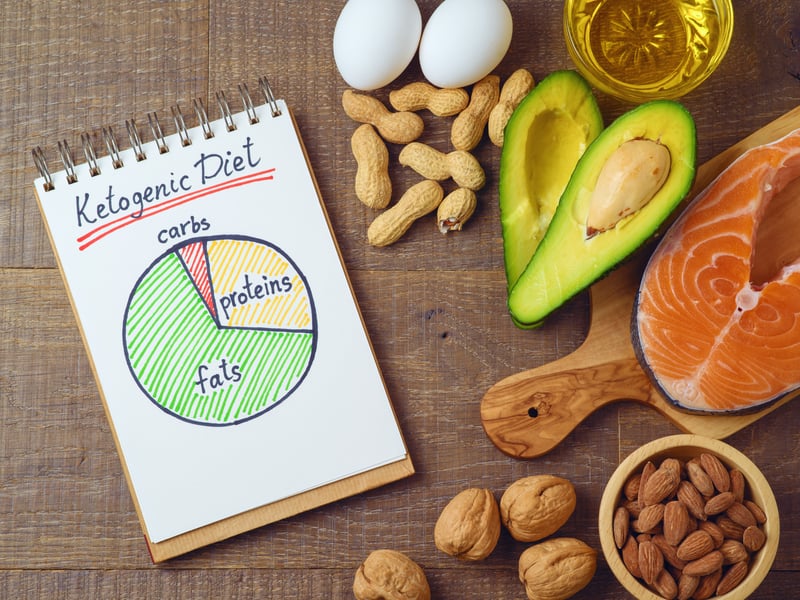What is the Keto Flu? And 10 Ways to Get Rid of It

Thinking about joining the droves and giving the increasingly popular ketogenic diet a try? Maybe you’ve enthusiastically started keto, and in a few days’ time, noticed you’re feeling like, for a lack of a nicer term, crap? Whether you’re already keto, thinking about trying keto, or have gone keto before, chances are you’re familiar (perhaps intimately so) with what’s often referred to as the keto flu. What is the keto flu? Good news: The keto flu—at least as you may know it—is not inevitable, and here we provide 11 tools from the keto toolbox to help you beat it.
Getting Keto Ready
So, you’re really going to do it. You’re going to take the plunge, join the masses, and give keto a shot. Why not? It seems like everyone else—from your family and friends to celebrities and sports stars—is doing it, and more importantly, keto seems to be working (in some cases, quite impressively) for quite a few people.
You’ve cleaned out all the processed garbage from your pantry. You’ve done your keto grocery shopping. And so far, you haven’t violated the cardinal rule of keto: You’ve done a killer job of keeping your carbs under 30 grams per day.
In just the first couple days, you’re already getting some positive feedback from your body, the scale, and the people around. Winning!
BAM!
Then, seemingly out of nowhere, you run into a brick wall. And it feels literal, like poor ol’ Wile E. Coyote. You’re tired (and wired). You’re trying to navigate through brain fog that’s denser than the air in the Grand Banks off the coast of Newfoundland (the foggiest place in the world). Your energy levels…what energy? And your cravings? Let’s just say you’ve imagined your coworkers’ heads have looked like pizza, bread, and chocolate.
Okay, I’m embellishing a bit, but you get the point. This, my friend, is what’s often referred to as the keto flu, although these side effects are not specific to keto. In fact, people used to simply refer to this as the “low-carb flu,” and it can sneak up when transitioning to any low-carb diet (including Paleo), which typically means less than 130 grams of carbs per day.
Keto Flu Symptoms
The keto flu refers to a constellation of issues (literally, flu-like symptoms) that some (but not all) people experience when embarking on the ketogenic or other low-carb diet, including:
- Brain fog
- Headache
- Nausea
- Muscle cramps
- Increased heart rate
- Fatigue
- Lethargy
- Feeling light-headed
- Difficulty sleeping
- Sugar cravings
- Digestive discomfort
- Constipation
But, What is the Keto Flu?
Okay, you know (perhaps all too well) how it feels, but what is the keto flu? Let’s face it, keto is a significant departure from “normal” for most people, whose bodies are heavily reliant on carbs.
Adapting to keto—and switching from relying on primarily carbs for fuel to burning fat (and ketones) almost exclusively—can take some time. Think about it this way: You’ve been eating a certain way for the majority of your life, and your body has adapted accordingly (albeit in some negative ways). Even though you can change your diet overnight, the body takes time to adapt.
Most people aren’t metabolically flexible enough to make this transition very smoothly. Metabolic flexibility simply refers to “the capacity for the organism to adapt fuel oxidation to fuel availability.”1 In simple terms, that means your body can efficiently and effectively switch between using carbs and fats for fuel based on what you make available.
Along these lines, someone who’s metabolically flexible shouldn’t have as much trouble shifting from a typical diet to a low-carb diet like keto. On the other hand, the keto flu is much more likely to strike those who are metabolically inflexible.
Here’s another way to think about what the keto flu is. In a way, it’s your body withdrawing from a long, heavy reliance on carbohydrates. Your body has been conditioned to be a carb-burner, and with keto, you’re forcing it to learn (or relearn) how to become a fat-burning machine. In other words, the low-carb flu is basically a manifestation of an adaptation to the ketogenic diet. And like many things in life, change often brings with it some discomfort.
BONUS: If you want to take a deeper dive into the low-carb flu (and metabolic flexibility), then you have to check out this epic article from J. Stanton of Gnolls.org.
As far as when the keto flu can strike, it varies considerably from person to person. Like I mentioned, not everyone gets hit (or hit quite as hard). In general, most keto-goers experience the keto flu within the first week of starting keto. While some folks find that the keto flu-like symptoms can linger into the second week—perhaps even the third, fourth, or fifth weeks—most people can turn the corner very quickly (or mitigate the keto flu altogether) with a well-formulated ketogenic diet and some of the nifty remedies shared below.
11 Remedies to Defeat Keto Flu
Now that we’ve covered what is the keto flu, let’s talk about some tips that might help if you’re having trouble adjusting to a ketogenic or other low-carb lifestyle. While one or more of these strategies may be quite useful for you, keep in mind that the keto flu is real.
Your mind is not playing tricks on you. You’re not weak.
So, while giving yourself time to adapt is important, don’t beat yourself up. Don’t think there’s something “wrong” with you. Also, keep in mind that low-carb diets like keto are not for everyone. Put your best foot forward, but always listen to your body.
1. Don’t fear the fat. Remember, keto is a high-fat diet—with 70 – 80% of calories coming from fat, generally speaking. Quite often, folks who’ve been brainwashed to believe that fat is bad don’t eat enough fat, which you’ll need to help you feel full and satisfied and to provide energy as your body adapts.
2. Eat enough calories. For most people, keto means elimination. It means getting rid of junk food and foods that contain processed carbs. While there’s no question, those are positive dietary moves, it often leads to people not eating enough. Yes, if weight loss is the goal, then you need to eat fewer calories than you burn. However, cutting calories too much too fast can be a big contributor to many of the keto flu symptoms. You don’t need to be neurotic about counting calories, but it may be a helpful guide when you’re getting started with keto.
3. Easy on the protein. While I’ve extolled the potential benefits of higher-protein diets many a time, keep in mind that keto is a moderate-protein diet—with roughly 15 – 30% of calories coming from protein. Eating too much protein can be problematic. On one hand, the satiating power of protein may keep you from eating enough fat and calories overall. On the other hand, too much protein may impair the body’s ability to make ketones (i.e., ketogenesis)—either through the process of converting excess protein to carbs (gluconeogenesis) or simply burning it for energy (prioritizing amino acids over fats).
4. Remember the cardinal rule of keto. The first (and most important) rule of keto is to keep carbs under 30 grams per day. Those carbs add up quickly, especially when you’re eating some nuts, seeds, dairy, and even fruits (avocados) and green veggies. And carbs add up even faster if you include keto foods that contain sugar alcohols and added fiber. Along those lines, forget net carbs. Be strict with the 30-gram limit when you’re getting started. Having said that, some folks (especially more active people who carry more muscle mass) might benefit from more clean carbs.
5. Drink up. With keto, you rapidly run through and deplete the body’s stored form of carbohydrate (called glycogen), and along with that glycogen, quite a bit of water (for every gram of glycogen, the body stores four grams of water). In other words, you lose a lot of water when starting keto. In fact, that’s why the numbers on the scale drop so rapidly early on. Plus, the kidneys tend to excrete more water when insulin and blood glucose levels drop like they do with carbohydrate restriction. Along these lines, make sure you’re drinking plenty of water. After all, even mild dehydration can explain nearly every one of the symptoms of the keto flu.

6. Get salty. Like fat, salt is not the demon we’ve been led to believe. And when you’re keto, you’re going to need to pay particularly close attention to your sodium intake. On one hand, the cardinal keto rule (30 grams of carbs) leads to eliminating most processed foods, which are the major source of dietary sodium. Plus, carbohydrate restriction results in the kidneys excreting more sodium and other electrolytes (such as potassium, magnesium, calcium, and chloride) as a result of a drop in insulin. If you’re exercising regularly, which we strongly recommend, then you should be getting 3 – 5 g/day of sodium and 2 – 3 g/day of potassium.2 For magnesium, 300 – 500 mg is a good target.
7. Get moving (if you can). Exercise? Are you kidding me? That’s what you might be thinking. Believe me, I know how it feels. If you’re not used to exercising regularly, that may be the last thing on your mind. If you do typically work out, then you’re likely to feel like your body has been taken over—your legs feel like lead and you feel like you’re moving at a snail’s pace. Don’t worry, your performance is likely to only temporarily be compromised. The truth is that all activity and exercise that you can muster may help in accelerating the adaptation period by depleting your carbohydrate stores and ramping up your body’s shift to burning fat. If you can do some interval-style training, that may be particularly effective.
8. Easy on the booze. You don’t have to completely abstain from alcohol on the ketogenic diet. However, when you’re first getting started with keto, it may be a good idea to limit the booze, but after adaptation, a glass of dry red wine or another keto-approved alcoholic beverage shouldn’t be a problem.
9. Experiment with intermittent fasting. Carbohydrate restriction isn’t the only way to cajole the body into ketosis. Fasting is arguably even more effective, and along those lines, experimenting with intermittent fasting (such as time-restricted feeding) may accelerate the adaptation period. In fact, researchers now believe that many of the health benefits of intermittent fasting may be due to flipping the metabolic switch from burning sugar to using fats and ketones for fuel.
10. Stick with it. Admittedly, not the best advice, but this too shall pass. Generally speaking, after climbing the adaptation mountain, many people enjoy a bounty of benefits with keto. Stick with it, make sure you can check off all the boxes above, and listen to your body.
The Keto Flu Fighters
Now you know what the keto flu is, what causes it, and what you might expect when transitioning to the ketogenic lifestyle or other low-carb diet. Perhaps more importantly, you’ve now got 11 tools in your keto toolbox to help remedy—or completely avoid altogether—the keto flu. Commit to the plan and put your best foot forward. Like most things in life, change brings discomfort, and when we overcome obstacles, we are often much better for it.
Keep in mind that the keto flu is for real, and we are all as unique as our fingerprints. Even with a well-formulated ketogenic diet and checking off all the boxes above, be mindful that keto is not for everyone. In other words, always listen to your body.








